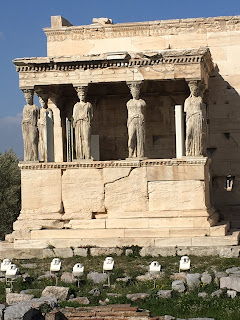Something I think is cool about Athens is it's Acropolis. This Acropolis is so old its creation is shrouded by a myth.
When the people of ancient Greece stopped being peaceful farmers they started creating cities on top of places like the Acropolis. The Acropolis served as a very good defensive position for the time when all of the city-states were attacking each other for resources. The Acropolis lays on a big rocky ridge that juts out of the Attica plateau along with the Lykavittos Hill, which we climbed yesterday. The rock rises up over two hundred feet and has a length of around nine hundred feet and a width of about four hundred and fifty feet.
 |
| Theater of Dyonisos |
The Acropolis was first inhabited in 4,000 to 3,000 BC. The first temples were built on the Acropolis in the Mycenaen era starting around 1400 BC. People lived there until the 6th century BC, then in 510 BC the oracle of Delphi declared it must be the province of the gods and everyone had to move and it became a religious place. Later in 480 BC the buildings were destroyed by the Persians on the eve of the Battle of Salamis. Pericles rebuilt the Acropolis into a city of temples, which is considered to be the Grecian's biggest architectural achievement.
 |
| Columns of the Parthenon |
 |
| Temple of Poseidon |
There is an interesting myth on how Athens started. Athena and Poseidon had a competition to see who would be the patron, deity, and name for Athens. They each had to produce a gift for the soon to be Athenians, Athena produced an olive tree, symbol of peace and prosperity, and then Poseidon struck the ground with his trident and a stream of salt water sprayed out. The Gods thought that Athena's gift was more suitable because it would supply the Athenians with food, oil, and wood. Even today there is an olive tree next to the temple of Poseidon on the Acropolis. To this day she still dominates most of Athens' mythology and monuments are built for her.
 |
| Athena's Olive Tree |
Sources:
- Ancient-Greece.org. http://ancient-greece.org/history/acropolis.html
- Lonely Planet Guidebook of Greece


Thanks for some history on Acropolis. What a beautiful day to explore such a historical site.
ReplyDelete